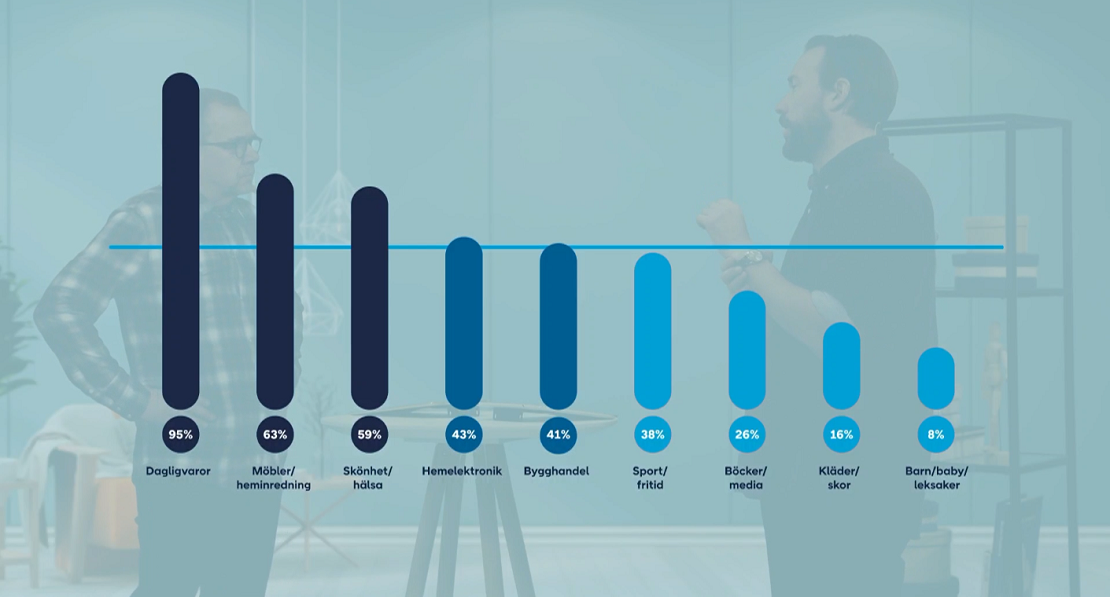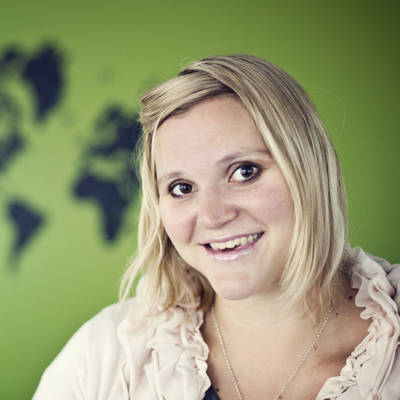
The day began with a fireside chat before the day started with moderator Ellinor Persson, Cecilia Tall, Secretary General at TEKO (Swedish Textile and Fashion Company) and Peter Hesslin, Head of e-commerce and logistics at PostNord. They reasoned that it does not have to be uneconomical to work more sustainably, there are many examples when you can make money on an investment fairly quickly. They also talked about the packaging and working on transporting less air. If the original packaging is sufficient to be sent, there is no reason to send a box in a box. They also talked about the importance of not getting stuck in old habits and thinking about whether it is possible to change.
The report E-barometern 2020
Then it was finally time to present the report E-barometern 2020. Arne Andersson, E-commerce advisor and Carl-Fredrik Teder, Retail Analyst at PostNord began by looking back at the forecast they issued in February 2020 for the full year which was then 11% growth. This was before the Corona pandemic really took off and we have since then seen record after record set for e-commerce in Sweden. The forecast was later revised up to 33% with an uncertainty regarding Christmas trade. When the Christmas gift report came, it showed an increase of 60% for just Christmas gifts online.
Growth for Q4 was 56% and for the full year 2020 it landed on 40%. The grocery trade has almost doubled with an increase of 95% online. Furniture and home furnishings are another big winner with 63% up. Beauty and health, which also includes pharmacy goods, increased by 59%, as there are many new e-shoppers in the older target group. All industries have taken a big step in e-commerce.
85% shopped online during November and December in Sweden, Arne Andersson thinks this is one of the most important things to take with you from the report. There will be a digital version of the report E-barometer where you can go in and work with the numbers to be able to go into more detail for different industries and age groups for what is most interesting for your own business.
Arne and Carl-Fredrik are reasoning about the forecast for 2021. It is likely that during the beginning of the year we will continue to have a Corona effect with strong growth during Q1 and that during the second part of the year we will return to a more normal everyday life with more store purchases than today. For the full year 2021, the forecast is now 7% after an extremely strong year to compare with.
The packaging journey - towards a more climate-smart e-commerce
Sofia Leffler-Moberg, who is Head of Sustainability at PostNord, has devoted herself to measuring how much air there is in different packages she receives. The record is 98% air. This is probably what everyone agrees is unsustainable, everyone must devote more energy to optimizing packages.
The packaging trip is a project together with Chalmers. Kajsa Hulthén is Assistant Professor at Chalmers University of Technology and talks about that packaging is dependent on several different industrial systems such as packaging machines, labels and package terminals. It should be very easy to get rid of the air in transports, but can also be very difficult. Business logics collide, the labels may be too large for the smallest packages.
DS Smith is also involved in the Förpackningsresan project with PostNord. Jonas Norberg who is Sales Manager at DS Smith talks about the packaging being good enough, sometimes they are far too good, but sometimes not enough and then the product itself can risk being damaged, whereupon the environmental impact becomes even greater with a new product and delivery.
Environmental monitoring - Circular consumption
Second hand, resell, reuse, preused, vintage, the used market is growing big. Emma Hernell, Vice President at HUI, Handelns Utredningsinstitut, says that the American market for second-hand is growing by 30% per year. Whether it is digital or physical, consumers state that what drives the market is experience, price focus and values. Among the sites that consumers state that they have shopped most used in the report E-barometern 2020, Tradera is listed at the top, followed by Facebook in private buying and selling groups, Facebook Marketplace and Blocket in Sweden. The strongest driving force for shopping second-hand online is that it is cheaper and more sustainable according to the Swedish consumers who responded to the survey.
Emma talks about the retailers who are starting to use second-hand goods can add value by driving flows to stores, building a sustainable brand and an opportunity to manage surpluses and returns. She mentions different business models such as platforms where different used products can be gathered, concept stores and the rental option where you do not have to own all the clothes and products you want to use. She gives tips on looking at starting collaborations with companies that, for example, rent out or upgrade, or extend the product's life by adding products, spare parts and repair services.
Part of a more circular consumption
A few months ago, Cervera Vintage was launched where private individuals can sell their old items that are based in the kitchen and dining area to Cervera, which sells these on the e-commerce site. Emma Ohlson, Operations Manager at Cervera Vintage, says that they have a nationwide network of stores that work excellently as drop-off points for vintage items. Unlike some other used product sites, Cervera buys them and bears the risk if they are not sold.
Sebastian Rudenstam, one of the founders of Beleco which rents out furniture, says that everything had to be changed when the Corona pandemic changed our everyday lives. From moving away from short-term rent, they instead had to start working more long-term with monthly subscriptions and home offices. They do not buy any furniture, but have gone directly to the manufacturers and retailers who, instead of selling them, rent them out together with Beleco so that they can make money on an existing product over and over again. When it comes to switching to a more circular thinking, it is important when budgets and forecasts are set to consider that instead of getting an direct income, you will directly make money for a longer period of time on a product.
Christiane Dolva Törnberg, Head of Sustainability at Fjällräven, talked about the need for innovations and more collaborations that may not always be traditional in order to have a more circular trade. She talks about how they look at a product based on the importance of functionality, physical durability, the ability to repair the product and a timeless design. Christiane was at Retail Day when it was a physical event a couple of years ago wearing her grandmother's Fjällräven jacket which she inherited - long life for the products creates the conditions for circular consumption.
